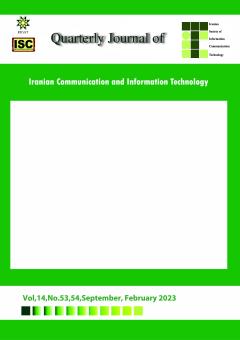Modeling and evaluation of RPL routing protocol by colored Petri nets
Subject Areas : ICTMohammad Pishdar 1 , Younes Seifi 2
1 -
2 - پژوهشگاه ارتباطات و فناوری اطلاعات
Keywords: كليد واژه انگلیسیColored Petri nets, Internet of Things (IoT), Routing Protocol for LLNs (RPL),
Abstract :
The Internet of Things (IoT) is a novel and widely used idea aimed at connecting objects through communication technologies. The problem of the prior technology adaptation has always been one of the most challenging issues in this area over the years. The Recognition of Prior Learning (RPL) protocol has been proposed by scientists since 2012 as a solution for IoT routing. This protocol has been utilized by many researchers and hardware companies in the field of the mentioned technology. The present study evaluates RPL behavior from the perspective of the existence of stopping conditions, crossing multiple routes from a special route (loop conditions), and how it reacts to different inputs, while presenting a modular and readable model of this protocol.
[1] Kamble, A., Malemath, V. S., & Patil, D. (2017). Security attacks and secure routing protocols in RPL-based Internet of Things: Survey. 2017 International Conference on Emerging Trends & Innovation in ICT (ICEI). Published. https://doi.org/10.1109/etiict.2017.7977006
[2] Adat, V., & Gupta, B. B. (2017). Security in Internet of Things: issues, challenges, taxonomy, and architecture. Telecommunication Systems, 67(3), 423–441. https://doi.org/10.1007/s11235-017-0345-9
[3] Lamaazi, H., & Benamar, N. (2020). A comprehensive survey on enhancements and limitations of the RPL protocol: A focus on the objective function. Ad Hoc Networks, 96, 102001. https://doi.org/10.1016/j.adhoc.2019.102001
[4] Winter, T., Ed., Thubert, P., Ed., Brandt, A., Hui, J., Kelsey, R., Levis, P., Pister, K., Struik, R., Vasseur, JP., and R. Alexander, "RPL: IPv6 Routing Protocol for Low-Power and Lossy Networks", RFC 6550, DOI 10.17487/RFC6550, March 2012,
[5] Iova, O., Picco, P., Istomin, T., & Kiraly, C. (2016). RPL: The Routing Standard for the Internet of Things. . . Or Is It? IEEE Communications Magazine, 54(12), 16–22. https://doi.org/10.1109/mcom.2016.1600397cm
[6] Kamgueu, P. O., Nataf, E., & Ndie, T. D. (2018). Survey on RPL enhancements: A focus on topology, security and mobility. Computer Communications, 120, 10–21. https://doi.org/10.1016/j.comcom.2018.02.011
[7] Coloured Petri Nets: Modelling and Validation of Concurrent Systems by Kurt Jensen (2009–07-01). (2021). Springer
. [8] Zaitsev, D. A., & Shmeleva, T. R. (2019). Modeling With Colored Petri Nets. Automated Systems in the Aviation and Aerospace Industries, 378–404. https://doi.org/10.4018/978-1-5225-7709-6.ch014
[9] Chen, Y., Hou, K., Chanet, J., & GHOLAMI, K. (2013). A RPL based Adaptive and Scalable Data-collection Protocol module for NS-3 simulation platform. NICST 2013
. [10] Bartolozzi, L., Pecorella, T., & Fantacci, R. (2012). ns-3 RPL module: IPv6 Routing Protocol for Low power and Lossy Networks. ACM. https://doi.org/10.4108/icst.simutools.2012.247718
[11] Karkazis, P., Trakadas, P., Zahariadis, T., Hatziefremidis, A., & Leligou, H. C. (2012, June). RPL modeling in J-Sim platform. 2012 Ninth International Conference on Networked Sensing (INSS). https://doi.org/10.1109/inss.2012.6240559
[12] Tripathi, J., de Olive, J. C., & Vasseur, J. P. (2010, March). A performance evaluation study of RPL: Routing Protocol for Low power and Lossy Networks. 2010 44th Annual Conference on Information Sciences and Systems (CISS). https://doi.org/10.1109/ciss.2010.5464820
[13] Becker, M., Kuladinithi, K., & Görg, C. (2012). Modelling and Simulating the Trickle Algorithm. Lecture Notes of the Institute for Computer Sciences, Social Informatics and Telecommunications Engineering, 135–144. https://doi.org/10.1007/978-3-642-30422-4_10
[14] Kristensen, L. M., & Veiset, V. (2016). Transforming CPN Models into Code for TinyOS: A Case Study of the RPL Protocol. Application and Theory of Petri Nets and Concurrency, 135–154. https://doi.org/10.1007/978-3-319-39086-4_10
[15] Wallgren, L., Raza, S., & Voigt, T. (2013). Routing Attacks and Countermeasures in the RPL-Based Internet of Things. International Journal of Distributed Sensor Networks, 9(8), 794326. https://doi.org/10.1155/2013/794326
[16] Yu, W., Jia, M., Fang, X., Lu, Y., & Xu, J. (2020). Modeling and analysis of medical resource allocation based on Timed Colored Petri net. Future Generation Computer Systems, 111, 368–374. https://doi.org/10.1016/j.future.2020.05.010
[17] Shahidinejad, A., Ghobaei-Arani, M., & Esmaeili, L. (2019). An elastic controller using Colored Petri Nets in cloud computing environment. Cluster Computing, 23(2), 1045–1071. https://doi.org/10.1007/s10586-019-02972-8
[18] Cavone, G., Dotoli, M., & Seatzu, C. (2018). A Survey on Petri Net Models for Freight Logistics and Transportation Systems. IEEE Transactions on Intelligent Transportation Systems, 19(6), 1795–1813. https://doi.org/10.1109/tits.2017.2737788
[19] Bhandari, G. P., & Ratneshwer. (2018). Dependency-based fault diagnosis approach for SOA-based systems using Colored Petri Nets. Journal of King Saud University - Computer and Information Sciences. Published. https://doi.org/10.1016/j.jksuci.2018.12.002
[20] Kaid, H., Al-Ahmari, A., Li, Z., & Davidrajuh, R. (2019). Single Controller-Based Colored Petri Nets for Deadlock Control in Automated Manufacturing Systems. Processes, 8(1), 21. https://doi.org/10.3390/pr8010021


